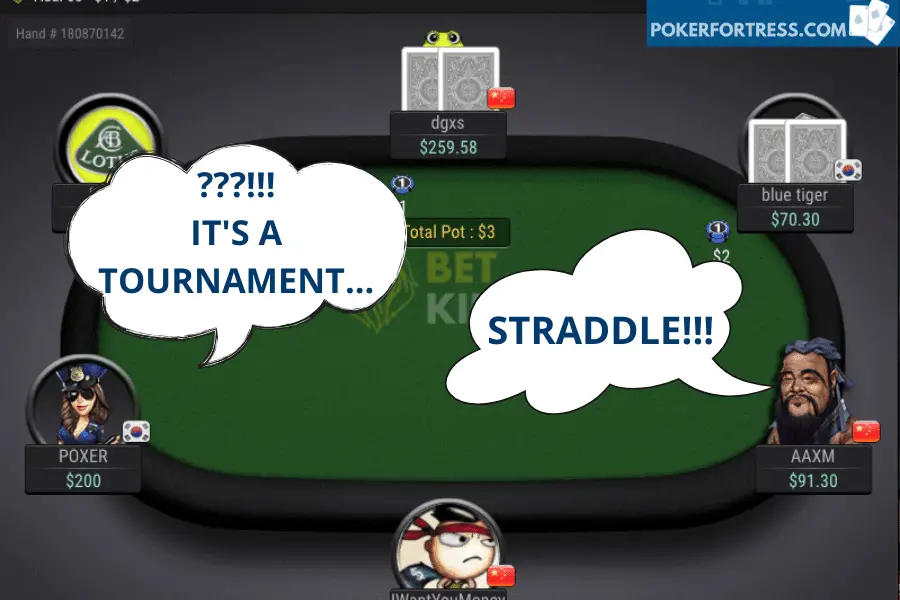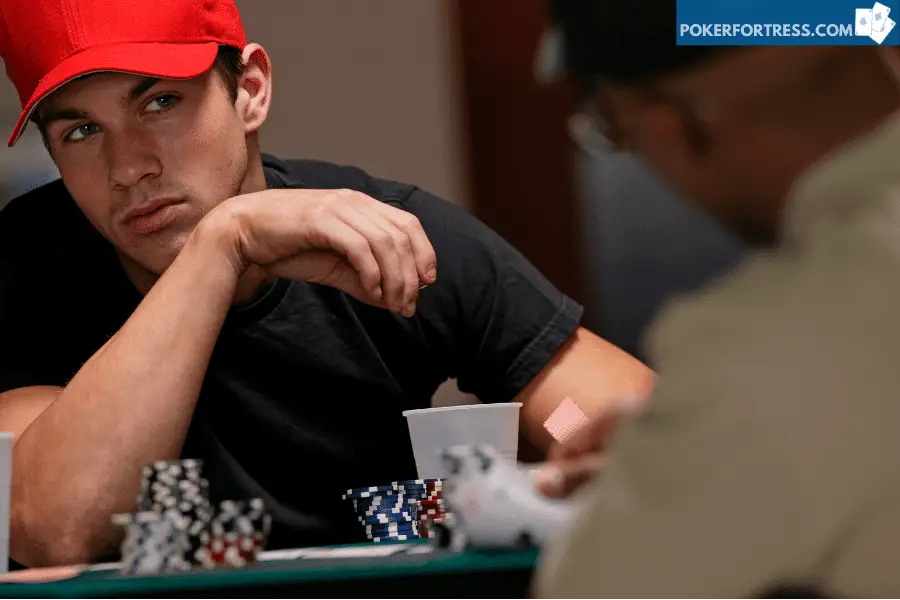Every one of us was a beginner at some point. We went to a friend’s poker game for the first time and finally posted the big blind. Then, a guy with more experience on our left shouted straddle and doubled the amount of our big blind before looking at his cards.

We had no idea of what was going on, but luckily everyone at the table rushed to explain the basics of straddling. Soon after that, we tried to straddle in a tournament organized by a local casino, but the dealer didn’t allow us to. What now!?
The general rule is that there is NO straddling in poker tournaments. They have set structure with the goal of providing every player at every single table with the same conditions. Additionally, with added structure, both players and organizers know how much time the tournament will last.
In the following article, you will find a bit more information about straddling, types of it, and other important information you should know about tournaments and their structure.
Why is there no straddle in tournaments? The straddle is designed to change the dynamics at the table, and as such, it would break the purpose of the tournament structure.
It could quickly happen that there would be a bunch of straddling at table X and no straddling at the table Y. That way, conditions wouldn’t be the same for everyone involved in the tournament. More so, it would completely change the end-game, when most stacks are short (less than 30BB). Someone could argue that the same goes for cash games, but there is a chance to change seats, tables, or even add money to your stack. You can’t do that while playing tournament poker.
Also, having straddle available at cash game increases action, and there is automatically more rake generated for the house. That’s not the case for tournaments, as the rake is pre-determined and is already included in your buy-in.

What is Straddle exactly?
- The straddle is an optional extra blind bet that should be placed before cards are dealt or at least before the player had the chance to look at his cards. Every casino, card room, or home game has (should have) rules about valid timing of straddle placement.
- The straddle bet usually is 2x the amount of the big blind. So if you are participating in 1$/2$ No Limit Hold’Em, the straddle should be 4$.
- In some games, it’s even possible to re-straddle. In that case, the person after the initial »straddler« needs to place 2x the amount of straddle. If we are still in the same game mentioned above where straddle is 4$, re-straddle should be 8$.
- After straddles are placed, and cards are dealt, a player on the left of the straddler is first to act preflop. When the flop is dealt, everything proceeds normally as the straddle does not affect the post-flop order in which players act.
- There are plenty of straddle variations in poker games around the world. Most common, the one described above, is called the UTG straddle. It means straddle can be placed or announced by the player seated directly to the left of the Big Blind.
- Other forms of straddling are called »The Mississippi Straddle, « where straddle can be placed by any player and »Button Straddle, « where straddling is done by a player on the button. Some cardrooms even allow »Un-Capped Straddle, «which means there is no limit to how much straddle can be, so some players just go all-in without looking at their cards. Games with the latter rule set can get very crazy.

After all this, you may be wondering if you should straddle or not? Read more about the reasons to straddle and when not to in this article.
Information about Tournament Structure
The structure depends on what kind of tournament you are playing in. You can choose between a single table or multi-table tournaments, turbo, regular or slow, freezeout, or rebuy. Additionally, there are shootouts, satellites, and knockouts.
Types of tournaments:
- Single table tournament (STTs): Only one table of players, the prize pool is a sum of all players buy-in.
- Multi-table tournaments (MTTs): More than one table of players battling out for a combined prize pool.
- Turbo, regular or slow: Based on the time it takes for blinds to increase
- Freezout: You get your chips and play until you either lose or win all of them.
- Rebuy: There is an option to get back in the tournament if you are eliminated, or your chip count falls below starting stack value.
- Shootout: You must win your table to move onto the next round.
- Satellite: A usually minor tournament that feeds into a larger event.
- Knockout: Every player in a tournament has a bounty. You get paid for every player you eliminate.
But no matter what kind of tournament you’re in, they all have one thing in common – blind increases as time goes by.
With the increase, blinds induce action, so the tournament ends in a reasonable and fairly predictable amount of time. What impacts structure the most is:
- A number of players. Generally, more players there are in a tournament, longer it will take for tournament to finish. Of course, more players mean more money in the prize pool too.
- The time it takes for blinds to increase. The most important thing when it comes to tournament structure. By the time it takes blind levels to increase, we determine if the tournament is fast, normal or slow.
- How much the blind increase. It’s also important how much blinds increase every round. In faster tournaments, the blind increase is usually bigger than it is in slower tournaments.
- The starting stack size. In combination with blind level length, we can deduct if the tournament is deep or shallow. Deep tournaments guarantee lots of postflop play, while shallow tournaments are based mostly on pre-flop decisions, especially in later stages.
The Blinds
Probably most of you already know what blinds are. For those who don’t, blinds are forced bets posted by players to the left of the dealer button. In most popular games nowadays, Texas Hold’em and Omaha, we have a small and the big blind. The small blind is, most of the time, half the big blind. Generally, big blind also equals the minimum bet.
Ante
Same as blinds, the ante is a forced bet. The difference is, compared to the blinds, that everyone at the table is required to post it.
That way, ante creates an additional incentive for players to be active. Players who fold every round will lose money even when they are not on the small or big blind. Also, with antes in the pot, the cost of staying in the hand is lower relative to the current pot size – pot odds get better, and action is more interesting.
The last few years brought changes regarding antes in live tournaments. To simplify and accelerate play, a person on the button pays ante for everybody.
Payout Structures
This is why we play, right? Because we want to amplify our investment and win money. Payout structures are mostly dependant on tournament size.
Smallest, single table tournaments (STTs), with 9 players, reward top 3 positions. In that scenario winner receives 50% of the prize pool, runner-up 30%, and third player gets the remaining 20%.
Prize pool distribution for STT with 9 players:
| Finishing position | Reward |
| 1 | 50% |
| 2 | 30% |
| 3 | 20% |
| 4-9 | 0 |
Payouts get a little bit more complicated in multi-table tournaments (MTTs), but rule stays the same – winner gets the most significant piece of the pie, while other players receive smaller portions.
Generally, between 10-25% of the field gets paid.
Prize pool distribution for MTT with 300 players:
| Finishing position | Reward |
| 1 | 23% |
| 2 | 15% |
| 3 | 9% |
| 4 | 7.5% |
| 5 | 5.5% |
| 6 | 4.5% |
| 7 | 3.5% |
| 8 | 3% |
| 9 | 2% |
| 10 | 1.5% |
| 11-20 | 0.9% |
| 21-30 | 0.85% |
| 31-40 | 0.8% |
| 41-300 | 0 |
As you can see from the table, pay jumps are getting bigger closer to the top. This is why, when playing tournaments, you should always play to win.
What have we learned today?
First of all, you got an answer to your initial question. There are no straddles in poker tournaments. You found out different types of straddles you can use during cash games. Additionally, you found out a lot of information about tournament poker, structures, and what they consist of.



